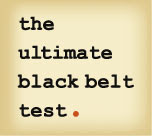Wednesday, June 11, 2008
This short video is an example of the kind of dialog you could have, must have, with your students and/or their parents. It talks benefits. It explains the ideas behind the methods. It is one example of how to approach your curriculum intelligently --and make it work for you both as a tool to reach and educate prospective members and to increase student retention.
This kind of video can be e-mailed, it can be added to a blog, it can go a website --and it most certainly is a tool that ought to be directly connected to your school's curriculum.
Thursday, May 29, 2008
Wednesday, May 28, 2008
Welcome to Intelligent Curriculum®
 Hi, Tom Callos here, I'm team coach for the Ultimate Black Belt Test -and I'm the head of the martial arts association known as The 100.
Hi, Tom Callos here, I'm team coach for the Ultimate Black Belt Test -and I'm the head of the martial arts association known as The 100.
Most of all, I LIKE THIS WORK --it's about improvement and change and authenticity for the martial arts.
See a copy of the WHITE to ORANGE BELT Curriculum, in black, Here.
Tuesday, May 27, 2008
How We Are Changing Our Belt Testing Program
We used to look at a martial arts belt test as something that took place in the future, something you prepared for and then “took” on a particular day.
“Ok John, your test will be on July 10, 2008 at 10:00 am in the morning. Have a clean uniform and bring your sparring gear.”
The new way we are looking at testing makes today the first day of your “test” –and everyday after that a continuation of your test, until you graduate.
What’s the difference?
 In the old model you might come to your test and be challenged to perform a 100 push ups. In the new model, you will have done 100 push-ups a day for 3 months.
In the old model you might come to your test and be challenged to perform a 100 push ups. In the new model, you will have done 100 push-ups a day for 3 months. Which do you think is more impressive, 100 push ups or 9000?
Which requires more self-discipline?
Which pays more tribute to “the journey” than to the “destination?”
With the old way, you might have come to your test and performed a form for the judges and the audience.
With the new method you will still perform at the graduation, but the real story behind your performance is that you documented 1000 repetitions of the form in preparation for your finale.
Instead of coming to your test and being required to fight 10 rounds of sparring, you will have been expected to complete 500 rounds during your three months of testing.
In this way, grand accomplishments, seemingly impossible feats, like 9000 push-ups, 1000 reps of a form, and 500 rounds of sparring, can easily be broken down into manageable, bite-sized pieces.
One hundred push ups can be done in 5 minutes. Three repetitions of a form can take 5 to 10 minutes. Three 3-minute rounds of sparring, with 1-minute breaks in between takes just 11 minutes.
 This kind of testing promotes the idea that self-improvement and transformation isn’t something that is put off or scheduled for a later date, it’s something we do in the here and now.
This kind of testing promotes the idea that self-improvement and transformation isn’t something that is put off or scheduled for a later date, it’s something we do in the here and now. It encourages students to look at every day as a testing day; a day when you want to be at your best. This method also allows the teacher to make his or her belt tests more comprehensive.
Test requirements can be expanded to include activities like reading and film viewing, acts of kindness, and community projects.
Monday, May 26, 2008
White to Orange Belt Curriculm: THE BASICS

Written for 8 to 15 years olds
To move from White Belt to Orange Belt a student attends classes for approximately 2 to 3 months.
- Physical Requirements

(Video Link here of all requirements).
Basic Stances
Footwork
Punches
Kicks
Defense
Ground
- Non-Physical Requirements
 Polite Greeting and Polite Departure
Polite Greeting and Polite Departure
School Orientation: Instructor’s Names, School Etiquette (forms of respect, care for uniform and other equip., school rules).
- One Community Based Project of the Student’s Own Choosing
(To be added to the school’s Project Portfolio)
100 Recorded Acts of Kindness
View the Video: Laugh at the Fat Kid (on youtube.com). Engage in home and in-class discussion about bullying –related to this film. - Repetition Requirements
1000 kicks & 1000 punches
A student must have completed 1000 repetitions of punches and kicks (any kick) before being eligible to test. One thousand kicking reps divided by 60 days equals less than 20 kicks a day.
500 Push Ups, 500 Crunches

The written requirements for your first belt test, The Basics, are the minimum requirements to pass to your next level of training.
The requirements may take you 2 months or it may take you longer, the point of the training is not to earn a new colored belt, it is to become proficient at learning on the mat, learning the basics, and developing a good relationship with the teacher and your fellow students.
The primary goal behind all of our training is to teach you how to take your martial arts “out of the dojo and into the world,” so your behavior and accomplishment at home and at school are just as important to your test as what you are able to do in our classes.
You should note that...
Fighting/Bullying
Fighting, in or out of our school, is not allowed. If you have someone you are in conflict with or someone who is picking on you, talk to your instructor and he or she will help you solve your problem –without resorting to violence.
Bullying other people is also something that is not allowed. If you recognize that you are playing the role of bully with someone else, talk to your teacher about it.
Chores/Room
You are expected to do home chores during your training –and the cleanliness of your room plays a major role in whether you are eligible to test and pass –or not.
The reason for this policy?
It’s simple: Your parents support you in this training –to make this a win-win situation, you must exchange your work at home for their transportation and financial support. If you’re unwilling to keep your room clean and do chores, then you are not demonstrating the kind of attitude we are working to build in our black belts.
If you need help with your chores, with having the self-discipline to do them, and with having a good and healthy attitude about doing them, just talk to your teacher –he or she will, no doubt, have some good advice for you.
Your Community-Based Project

The ultimate self-defense is found in developing an attitude, a viewpoint, which allows us to see both the ups and the downs –of training and of life –as something valuable and important.
Our goal is to stay the course to accomplishment, no matter the obstacles –as success will come, and when it does we will both have done something powerful for your child.
There are a few things you can do to help your child prepare for the successful completion of the first belt exam.
Developing the Connection Between "Practice" and "Success"
First, recognize that the “test” begins the day your child start classes. Creating a habit of daily practice is the real “test” of the training. There is more value in getting a child to practice every day (feel free to take Sundays off) than there is in successfully “testing” on the day of the final exam.
“Pick your battles carefully” is sage advice for parents –and martial arts teachers too. We would rather “fight the battle” of establishing the habit of daily practice than we would of what happens to a child’s self-esteem, attitude, and skill when they don’t practice.
Set Up A "Home Dojo"
Keep Us In The Loop
Help Us Teach By Example
 One of the BEST things you could do for your child is to do his or her required push-ups, crunches, and acts of kindness with him/her. Not only does it allow you to engage with your child in a unique way, but you make your own accomplishment a part of your child’s “test story.”
One of the BEST things you could do for your child is to do his or her required push-ups, crunches, and acts of kindness with him/her. Not only does it allow you to engage with your child in a unique way, but you make your own accomplishment a part of your child’s “test story.”“Sir, not only did I do 100 acts of kindness, but my Mom and Dad did 100 each too. So, here’s my journal with 300 acts of kindness!”





